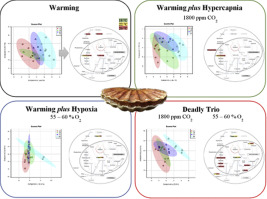当前位置:
X-MOL 学术
›
Comp. Biochem. Physiol. B Biochem. Mol. Biol.
›
论文详情
Our official English website, www.x-mol.net, welcomes your
feedback! (Note: you will need to create a separate account there.)
Single and combined effects of the "Deadly trio" hypoxia, hypercapnia and warming on the cellular metabolism of the great scallop Pecten maximus.
Comparative Biochemistry and Physiology B: Biochemistry & Molecular Biology ( IF 1.9 ) Pub Date : 2020-04-03 , DOI: 10.1016/j.cbpb.2020.110438 Sandra Götze 1 , Christian Bock 1 , Charlotte Eymann 1 , Gisela Lannig 1 , Jennifer B M Steffen 2 , Hans-O Pörtner 3
Comparative Biochemistry and Physiology B: Biochemistry & Molecular Biology ( IF 1.9 ) Pub Date : 2020-04-03 , DOI: 10.1016/j.cbpb.2020.110438 Sandra Götze 1 , Christian Bock 1 , Charlotte Eymann 1 , Gisela Lannig 1 , Jennifer B M Steffen 2 , Hans-O Pörtner 3
Affiliation

|
In the ocean the main climate drivers affecting marine organisms are warming, hypercapnia, and hypoxia. We investigated the acute effects of warming (W), warming plus hypercapnia (WHc, ~1800 μatm CO2), warming plus hypoxia (WHo, ~12.1 kPa O2), and a combined exposure of all three drivers (Deadly Trio, DT) on king scallops (Pecten maximus). All exposures started at 14 °C and temperature was increased by 2 °C once every 48 h until the lethal temperature was reached (28 °C). Gill samples were taken at 14 °C, 18 °C, 22 °C, and 26 °C and analyzed for their metabolic response by 1H-nuclear magnetic resonance (NMR) spectroscopy. Scallops were most tolerant to WHc and most susceptible to oxygen reduction (WHo and DT). In particular under DT, scallops' mitochondrial energy metabolism was affected. Changes became apparent at 22 °C and 26 °C involving significant accumulation of glycogenic amino acids (e.g. glycine and valine) and anaerobic end-products (e.g. acetic acid and succinate). In line with these observations the LT50 was lower under the exposure to DT (22.5 °C) than to W alone (~ 25 °C) indicating a narrowing of the thermal niche due to an imbalance between oxygen demand and supply.
中文翻译:

“致命三重奏”缺氧,高碳酸血症和变暖对扇贝大花蜜的细胞代谢的单一和综合影响。
在海洋中,影响海洋生物的主要气候驱动因素是变暖,高碳酸血症和缺氧。我们研究了升温(W),升温加高碳酸血症(WHc,〜1800μatmCO2),升温加缺氧(WHo,〜12.1 kPa O2)以及所有三种驱动因素(Deadly Trio,DT)的联合暴露的急性效应。扇贝王(Pecten maximus)。所有暴露均始于14°C,温度每48小时升高2°C,直到达到致死温度(28°C)。14样品分别在14°C,18°C,22°C和26°C下采集,并通过1H核磁共振(NMR)光谱分析其代谢反应。扇贝对WHc的耐受性最强,并且对氧气的减少最敏感(WHo和DT)。特别是在DT下,扇贝的线粒体能量代谢受到影响。变化在22°C和26°C时变得明显,包括大量糖原氨基酸(例如甘氨酸和缬氨酸)和厌氧终产物(例如乙酸和琥珀酸酯)的积累。与这些观察结果一致,在DT(22.5°C)下的LT50低于单独在W(〜25°C)下的LT50,这表明由于氧气供需之间的不平衡而导致的热生态位变窄。
更新日期:2020-04-06
中文翻译:

“致命三重奏”缺氧,高碳酸血症和变暖对扇贝大花蜜的细胞代谢的单一和综合影响。
在海洋中,影响海洋生物的主要气候驱动因素是变暖,高碳酸血症和缺氧。我们研究了升温(W),升温加高碳酸血症(WHc,〜1800μatmCO2),升温加缺氧(WHo,〜12.1 kPa O2)以及所有三种驱动因素(Deadly Trio,DT)的联合暴露的急性效应。扇贝王(Pecten maximus)。所有暴露均始于14°C,温度每48小时升高2°C,直到达到致死温度(28°C)。14样品分别在14°C,18°C,22°C和26°C下采集,并通过1H核磁共振(NMR)光谱分析其代谢反应。扇贝对WHc的耐受性最强,并且对氧气的减少最敏感(WHo和DT)。特别是在DT下,扇贝的线粒体能量代谢受到影响。变化在22°C和26°C时变得明显,包括大量糖原氨基酸(例如甘氨酸和缬氨酸)和厌氧终产物(例如乙酸和琥珀酸酯)的积累。与这些观察结果一致,在DT(22.5°C)下的LT50低于单独在W(〜25°C)下的LT50,这表明由于氧气供需之间的不平衡而导致的热生态位变窄。











































 京公网安备 11010802027423号
京公网安备 11010802027423号